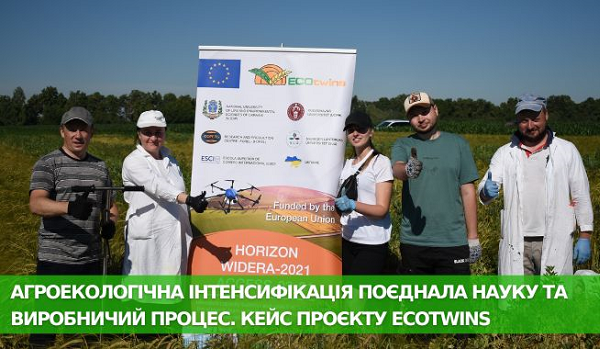Agroecological Intensification Bridging Science and Production: The Case of the ECOtwins Project
Agroecological intensification is an innovative approach to agriculture that combines productivity with environmental stewardship. How can we increase yields without depleting soil resources? How can we reduce the use of chemical fertilizers and pesticides while ensuring stable income for farmers?
We explore these possibilities and practical solutions with Dr. Oksana Tonkha, Professor of Agricultural Sciences and coordinator of the international ECOtwins project.
Tell us about the ECOtwins project. Who is involved, and what are its goals and objectives?
Oksana Tonkha: The project unites a consortium of four European universities and one scientific-industrial center, including Ukraine’s flagship in agribiological education and research — the National University of Life and Environmental Sciences of Ukraine (NUBiP).
The project's main goal is reflected in its extended title: “Strengthening Research Capacity and Skills of NUBiP’s Research Group (Ukraine) in Agroecological Intensification of Crop Production.” This goal involves two key directions: first, European universities share their knowledge and methodologies, which we implement in both research and production. Second, we conduct field experiments on innovative ecological technologies aimed at increasing crop yields.
What makes the project unique?
Oksana Tonkha: Each institution brings unique expertise. The Swedish University of Agricultural Sciences provides consulting on biostimulant preparation and evaluation. The University of Copenhagen offers methodologies and conducts parallel field studies. The International School of Commerce (Spain) assesses our technologies in terms of ecological impact, waste management, and carbon footprint. The production center “Forel” supplies fish hydrolysate-based biostimulants. NUBiP coordinates the consortium, allowing our scientists to gain invaluable experience integrating into the European research space.
What experiments have been conducted, and have they met your expectations?
Oksana Tonkha: Field experiments are conducted simultaneously in Ukraine and Denmark following a unified scheme. Our focus is on intercropping legumes and cereals and studying how biostimulants affect their growth, productivity, and yields. In 2023, we launched an experiment on the impact of various biostimulants on barley and pea intercrops under organic farming conditions.
Intercropping, as an alternative to monoculture farming, involves growing multiple plant species in the same field during one season. This system maximizes resource use, mitigates pest issues, reduces weed infestation, and enriches the soil with nutrients.
We have studied soil amendments like biochar and vermicompost and applied biological stimulants such as humus extracts, compost, and algae-based products during the growing season.
In 2024, we began a new experiment combining organic soil improvers with mineral fertilizers and added beans to the crop list. Preliminary results show that biostimulants significantly enhance biodiversity, which will positively affect subsequent crop rotations.
How can farmers implement agroecological intensification? Practical tips?
Oksana Tonkha: Our results are particularly beneficial for farmers transitioning to organic agriculture. Initial steps can be challenging — avoiding pesticides may reduce yields due to weeds, diseases, and pests, while cutting out mineral fertilizers limits yield potential. However, these are short-term effects.
Intercropping can lead to higher overall yields compared to growing crops separately. Farmers should plan for grain separation or use mixed crops, especially if they can utilize the mixture directly. This approach offers clean, protein-rich produce (thanks to nitrogen fixation) while keeping fields weed-free.
Biostimulants are versatile and improve crop yields, resilience to stress, and product quality across all farming systems.
What about international collaboration? Are these innovations adopted in Europe?
Oksana Tonkha: Europe has many research programs focused on enhancing biodiversity, including intercropping. Achieving 10% organic farming land is a global goal, and researchers are developing ways to boost agroecosystem productivity and resilience.
The University of Copenhagen has been studying intercropping for decades, focusing on crop potential and environmental impact. Data collected by NUBiP and Copenhagen University are analyzed by the International School of Commerce in Spain to identify best practices for decarbonization and waste reduction. The Swedish University enhances our expertise through knowledge transfer and training.
What innovations should producers focus on amidst wartime challenges?
Oksana Tonkha: Russia’s aggression has increased fuel costs, disrupted logistics, and reduced fertilizer use. As a result, crops like peas and barley hover on the brink of profitability. On the other hand, organic products, with higher market prices, are in demand in Europe.
Farmers must activate other nutrient sources, primarily the soil. Healthy soils foster nutrient availability and boost yields. Biostimulants perform well under organic and conventional systems alike. This is worth prioritizing.
What opportunities for business collaboration exist today?
Oksana Tonkha: NUBiP actively fosters collaboration with businesses, offering various mutually beneficial partnerships beyond student internships and graduate employment. Businesses influence curriculum development, mentor students, co-create educational environments with cutting-edge technologies, and sponsor research.
In October, we hosted the second “Science, Education, and Business – 2024” (SEB-2024) forum, where over 200 companies strategized effective partnerships for Ukraine's postwar recovery and European integration.
Collaboration strengthens yearly, and agriculture remains a cornerstone of Ukraine’s economy. Together with our partners, we create synergistic opportunities for growth.
Svitlana Yatsenko, AgroPortal.ua
